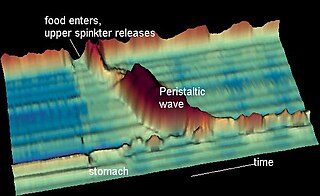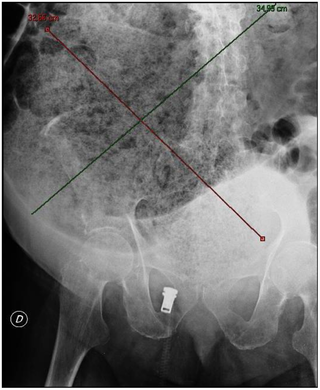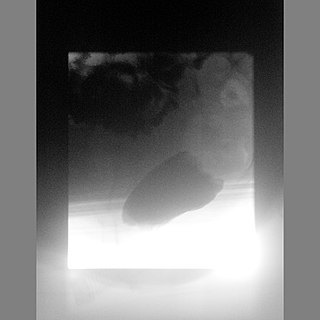Related Research Articles

Defecation follows digestion, and is a necessary process by which organisms eliminate a solid, semisolid, or liquid waste material known as feces from the digestive tract via the anus. The act has a variety of names ranging from the common, like pooping or crapping, to the technical, e.g. bowel movement, to the obscene (shitting), to the euphemistic, to the juvenile. The topic, usually avoided in polite company, can become the basis for some potty humor.

Peristalsis is a type of intestinal motility, characterized by radially symmetrical contraction and relaxation of muscles that propagate in a wave down a tube, in an anterograde direction. Peristalsis is progression of coordinated contraction of involuntary circular muscles, which is preceded by a simultaneous contraction of the longitudinal muscle and relaxation of the circular muscle in the lining of the gut.

Constipation is a bowel dysfunction that makes bowel movements infrequent or hard to pass. The stool is often hard and dry. Other symptoms may include abdominal pain, bloating, and feeling as if one has not completely passed the bowel movement. Complications from constipation may include hemorrhoids, anal fissure or fecal impaction. The normal frequency of bowel movements in adults is between three per day and three per week. Babies often have three to four bowel movements per day while young children typically have two to three per day.

Fecal incontinence (FI), or in some forms encopresis, is a lack of control over defecation, leading to involuntary loss of bowel contents, both liquid stool elements and mucus, or solid feces. When this loss includes flatus (gas), it is referred to as anal incontinence. FI is a sign or a symptom, not a diagnosis. Incontinence can result from different causes and might occur with either constipation or diarrhea. Continence is maintained by several interrelated factors, including the anal sampling mechanism, and incontinence usually results from a deficiency of multiple mechanisms. The most common causes are thought to be immediate or delayed damage from childbirth, complications from prior anorectal surgery, altered bowel habits. An estimated 2.2% of community-dwelling adults are affected. However, reported prevalence figures vary. A prevalence of 8.39% among non-institutionalized U.S adults between 2005 and 2010 has been reported, and among institutionalized elders figures come close to 50%.
Encopresis is voluntary or involuntary passage of feces outside of toilet-trained contexts in children who are four years or older and after an organic cause has been excluded. Children with encopresis often leak stool into their undergarments.
Functional gastrointestinal disorders (FGID), also known as disorders of gut–brain interaction, include a number of separate idiopathic disorders which affect different parts of the gastrointestinal tract and involve visceral hypersensitivity and motility disturbances.

A fecal impaction or an impacted bowel is a solid, immobile bulk of feces that can develop in the rectum as a result of chronic constipation. Fecal impaction is a common result of neurogenic bowel dysfunction and causes immense discomfort and pain. Its treatment includes laxatives, enemas, and pulsed irrigation evacuation (PIE) as well as digital removal. It is not a condition that resolves without direct treatment.

Enterochromaffin (EC) cells are a type of enteroendocrine cell, and neuroendocrine cell. They reside alongside the epithelium lining the lumen of the digestive tract and play a crucial role in gastrointestinal regulation, particularly intestinal motility and secretion. They were discovered by Nikolai Kulchitsky.

The Bristol stool scale is a diagnostic medical tool designed to classify the form of human faeces into seven categories. It is used in both clinical and experimental fields.

Bisacodyl (INN) is an organic compound that is used as a stimulant laxative drug. It works directly on the colon to produce a bowel movement. It is typically prescribed for relief of episodic and chronic constipation and for the management of neurogenic bowel dysfunction, as well as part of bowel preparation before medical examinations, such as for a colonoscopy.
The enterogastric reflex is one of the three extrinsic reflexes of the gastrointestinal tract, the other two being the gastroileal reflex and the gastrocolic reflex. The enterogastric reflex is stimulated by duodenal distension. It can also be stimulated by a pH of 3-4 in the duodenum and by a pH of 1.5 in the stomach. Upon initiation of the reflex, the release of gastrin by G-cells in the antrum of the stomach is shut off. This in turn inhibits gastric motility and the secretion of gastric acid (HCl).
Gastrointestinal physiology is the branch of human physiology that addresses the physical function of the gastrointestinal (GI) tract. The function of the GI tract is to process ingested food by mechanical and chemical means, extract nutrients and excrete waste products. The GI tract is composed of the alimentary canal, that runs from the mouth to the anus, as well as the associated glands, chemicals, hormones, and enzymes that assist in digestion. The major processes that occur in the GI tract are: motility, secretion, regulation, digestion and circulation. The proper function and coordination of these processes are vital for maintaining good health by providing for the effective digestion and uptake of nutrients.
The rectoanal inhibitory reflex (RAIR), also known as the anal sampling mechanism, anal sampling reflex, rectosphincteric reflex, or anorectal sampling reflex, is a reflex characterized by a transient involuntary relaxation of the internal anal sphincter in response to distention of the rectum. The RAIR provides the upper anal canal with the ability to discriminate between flatus and fecal material.

The rectum is the final straight portion of the large intestine in humans and some other mammals, and the gut in others. The adult human rectum is about 12 centimetres (4.7 in) long, and begins at the rectosigmoid junction at the level of the third sacral vertebra or the sacral promontory depending upon what definition is used. Its diameter is similar to that of the sigmoid colon at its commencement, but it is dilated near its termination, forming the rectal ampulla. It terminates at the level of the anorectal ring or the dentate line, again depending upon which definition is used. In humans, the rectum is followed by the anal canal which is about 4 centimetres (1.6 in) long, before the gastrointestinal tract terminates at the anal verge. The word rectum comes from the Latin rectumintestinum, meaning straight intestine.

Anorectal manometry (ARM) is a medical test used to measure pressures in the anus and rectum and to assess their function. The test is performed by inserting a catheter, that contains a probe embedded with pressure sensors, through the anus and into the rectum. Patients may be asked to perform certain maneuvers, such as coughing or attempting to defecate, to assess for pressure changes. Anorectal manometry is a safe and low risk procedure.

Anismus or dyssynergic defecation is the failure of normal relaxation of pelvic floor muscles during attempted defecation. It can occur in both children and adults, and in both men and women. It can be caused by physical defects or it can occur for other reasons or unknown reasons. Anismus that has a behavioral cause could be viewed as having similarities with parcopresis, or psychogenic fecal retention.
Obstructed defecation syndrome is a major cause of functional constipation, of which it is considered a subtype. It is characterized by difficult and/or incomplete emptying of the rectum with or without an actual reduction in the number of bowel movements per week. Normal definitions of functional constipation include infrequent bowel movements and hard stools. In contrast, ODS may occur with frequent bowel movements and even with soft stools, and the colonic transit time may be normal, but delayed in the rectum and sigmoid colon.

Ulimorelin is a drug with a modified cyclic peptide structure which acts as a selective agonist of the ghrelin/growth hormone secretagogue receptor (GHSR-1a).. Unlike many related drugs, ulimorelin has little or no effect on growth hormone (GH) release in rats. However, like ghrelin and other ghrelin agonists, ulimorelin does stimulate GH release with concomitant increases in insulin-like growth factor 1 (IGF-1) in humans. It has been researched for enhancing gastrointestinal motility, especially in gastroparesis and in aiding recovery of bowel function following gastrointestinal surgery, where opioid analgesic drugs used for post-operative pain relief may worsen existing constipation. While ulimorelin has been shown to increase both upper and lower gastrointestinal motility in rats, and showed promising results initially in humans, it failed in pivotal clinical trials in post operative ileus.
Constipation in children refers to the medical condition of constipation in children. It is a functional gastrointestinal disorder.

Neurogenic bowel dysfunction (NBD) is the inability to control defecation due to a deterioration of or injury to the nervous system, resulting in faecal incontinence or constipation. It is common in people with spinal cord injury (SCI), multiple sclerosis (MS) or spina bifida.
References
- 1 2 3 4 5 6 Malone, Jordan C.; Thavamani, Aravind (2019), "Physiology, Gastrocolic Reflex (Gastrocolic Response)", StatPearls, StatPearls Publishing, PMID 31751078 , retrieved 2020-01-14
- ↑ Lauralee, Sherwood (2009). Human Physiology: From Cells to Systems (7th ed.). Cengage Learning. p. 635. ISBN 978-0-495-39184-5.
- ↑ Tobias, Abraham; Sadiq, Nazia M. (2019), "Physiology, Gastrointestinal Nervous Control", StatPearls, StatPearls Publishing, PMID 31424852 , retrieved 2020-01-14
- ↑ Brown, Steven R.; Cann, P. A.; Read, Nicholas W. (1990). "Effect of coffee on distal colon function". Gut . 31 (4): 450–453. doi: 10.1136/gut.31.4.450 . PMC 1378422 .
- ↑ Eamudomkarn, Nuntasiri; Kietpeerakool, Chumnan; Kaewrudee, Srinaree; Jampathong, Nampet; Ngamjarus, Chetta; Lumbiganon, Pisake (2018). "Effect of postoperative coffee consumption on gastrointestinal function after abdominal surgery: A systematic review and meta-analysis of randomized controlled trials". Scientific Reports . 8. 17349. doi: 10.1038/s41598-018-35752-2 . PMC 6255780 .
- ↑ Sloots, Cornelius E.J.; Felt-Bersma, Richelle J.F.; West, Rachel L.; Kuipers, Ernst J. (2005). "Stimulation of defecation: Effects of coffee use and nicotine on rectal tone and visceral sensitivity". Scandinavian Journal of Gastroenterology . 40 (7): 808–813. doi:10.1080/00365520510015872.
- ↑ Dulskas, Audrius; Klimovskij, Michail; Vitkauskiene, Marija; Samalavicius, Narimantas (2015). "Effect of Coffee on the Length of Postoperative Ileus After Elective Laparoscopic Left-Sided Colectomy". Diseases of the Colon & Rectum . 58 (11): 1064–1069. doi:10.1097/DCR.0000000000000449. PMID 26445179.
- ↑ Nehlig, Astrid (2022). "Effects of Coffee on the Gastro-Intestinal Tract: A Narrative Review and Literature Update". Nutrients . 14 (2): 399. doi: 10.3390/nu14020399 . PMC 8778943 . PMID 35057580.
- ↑ Francis, Ali (2023-08-18). "Why Does Coffee Make You Poop?". Bon Appétit . Archived from the original on 2023-08-20. Retrieved 2023-10-27.
- ↑ "Why Coffee Makes You Poop". Cleveland Clinic. January 24, 2023.
- ↑ Sjölund K, Ekman R, Lindgren S, Rehfeld J (1996): Disturbed motilin and cholecystokinin release in the irritable bowel syndrome in Scand J Gastroenterol, 31:11, pp 1110–4, PMID 8938905, DOI 10.3109/00365529609036895